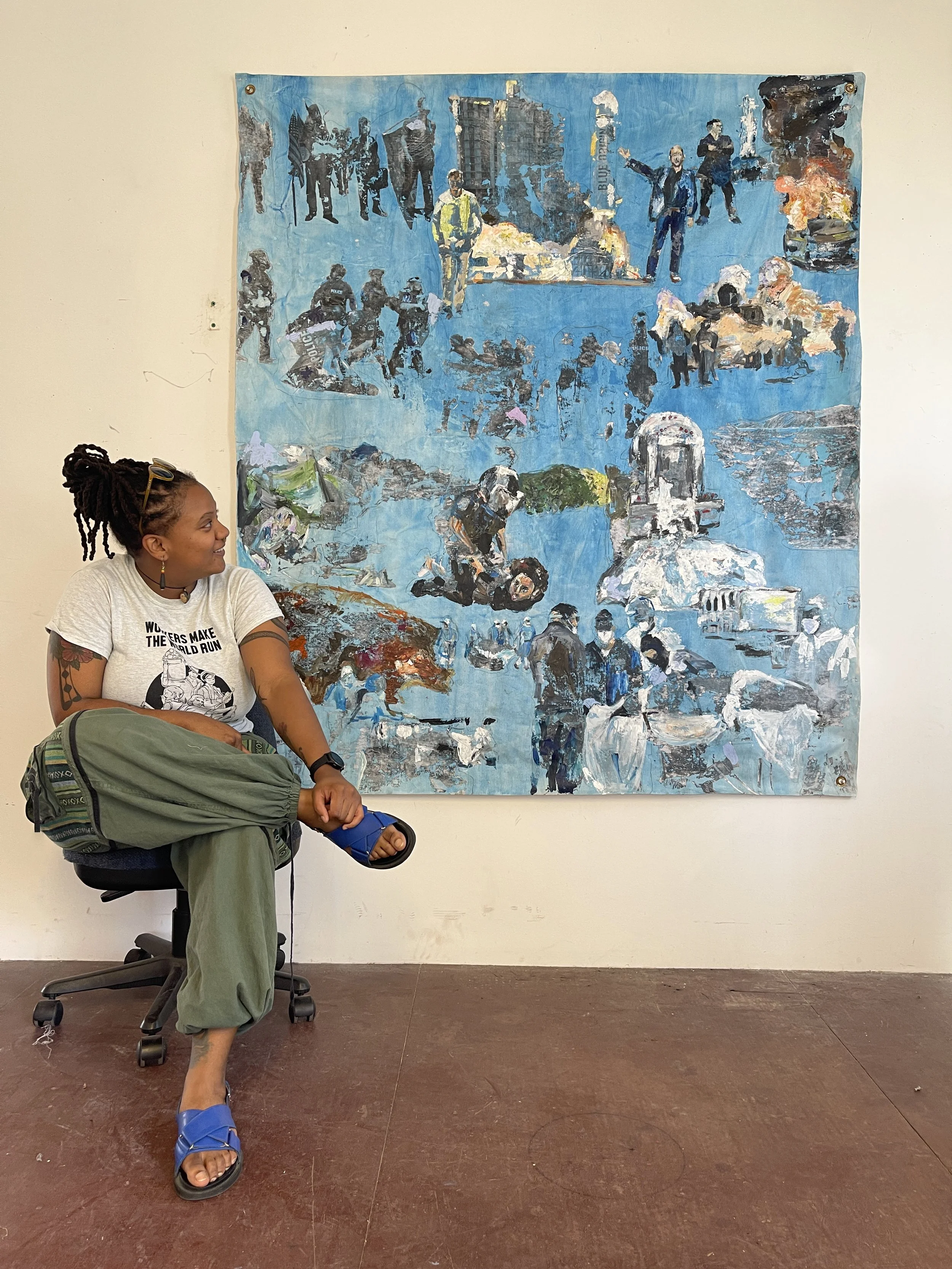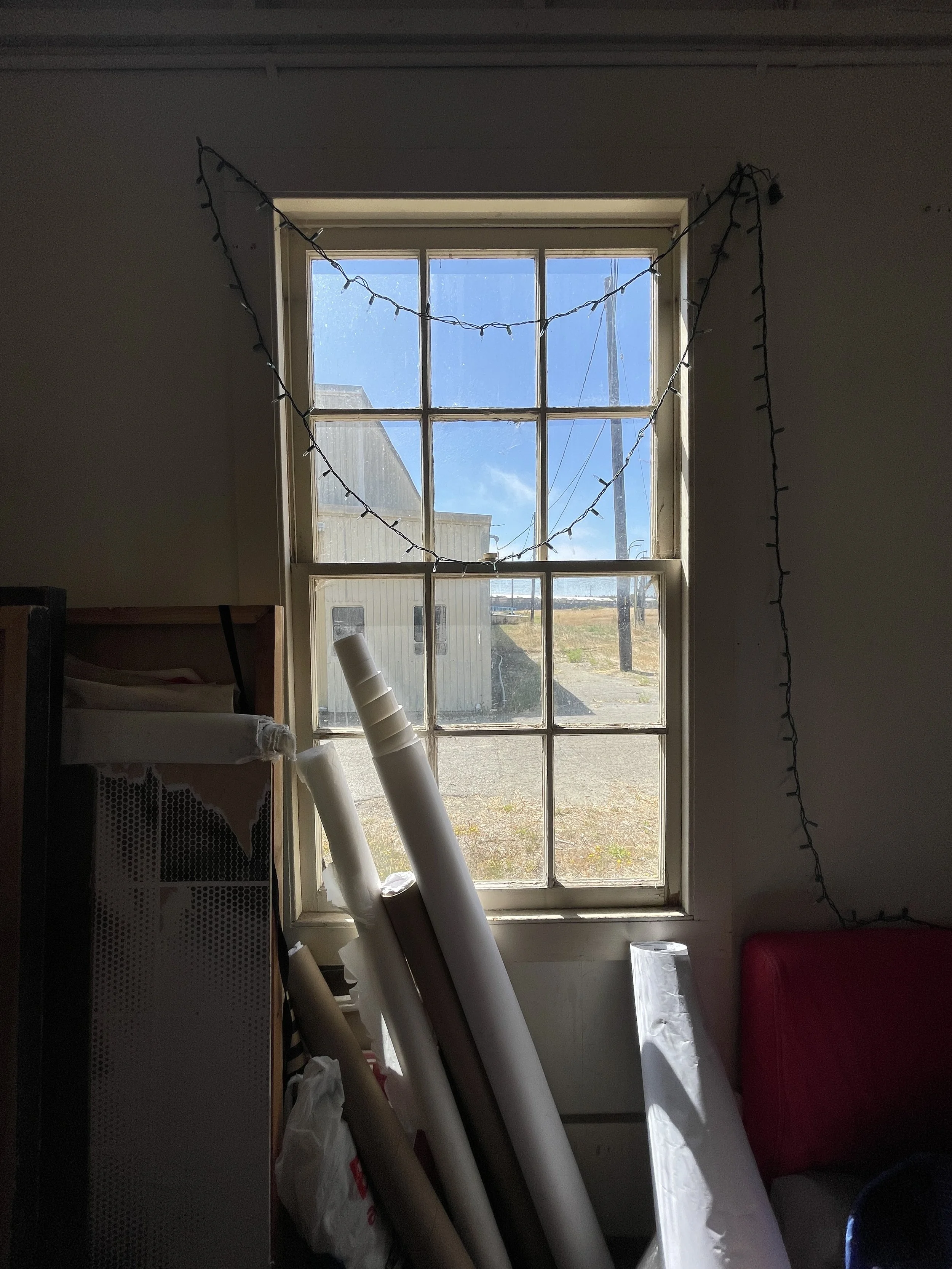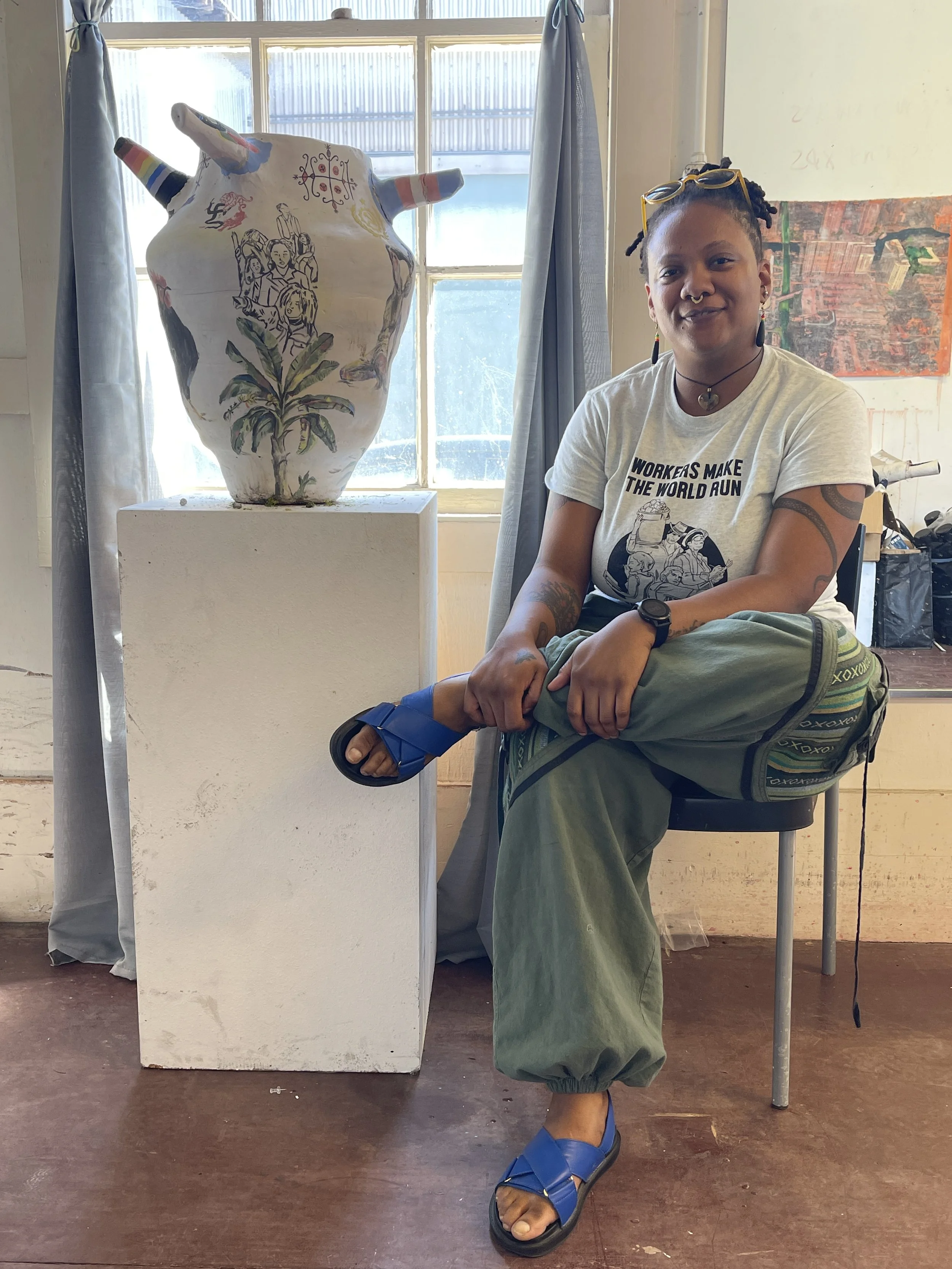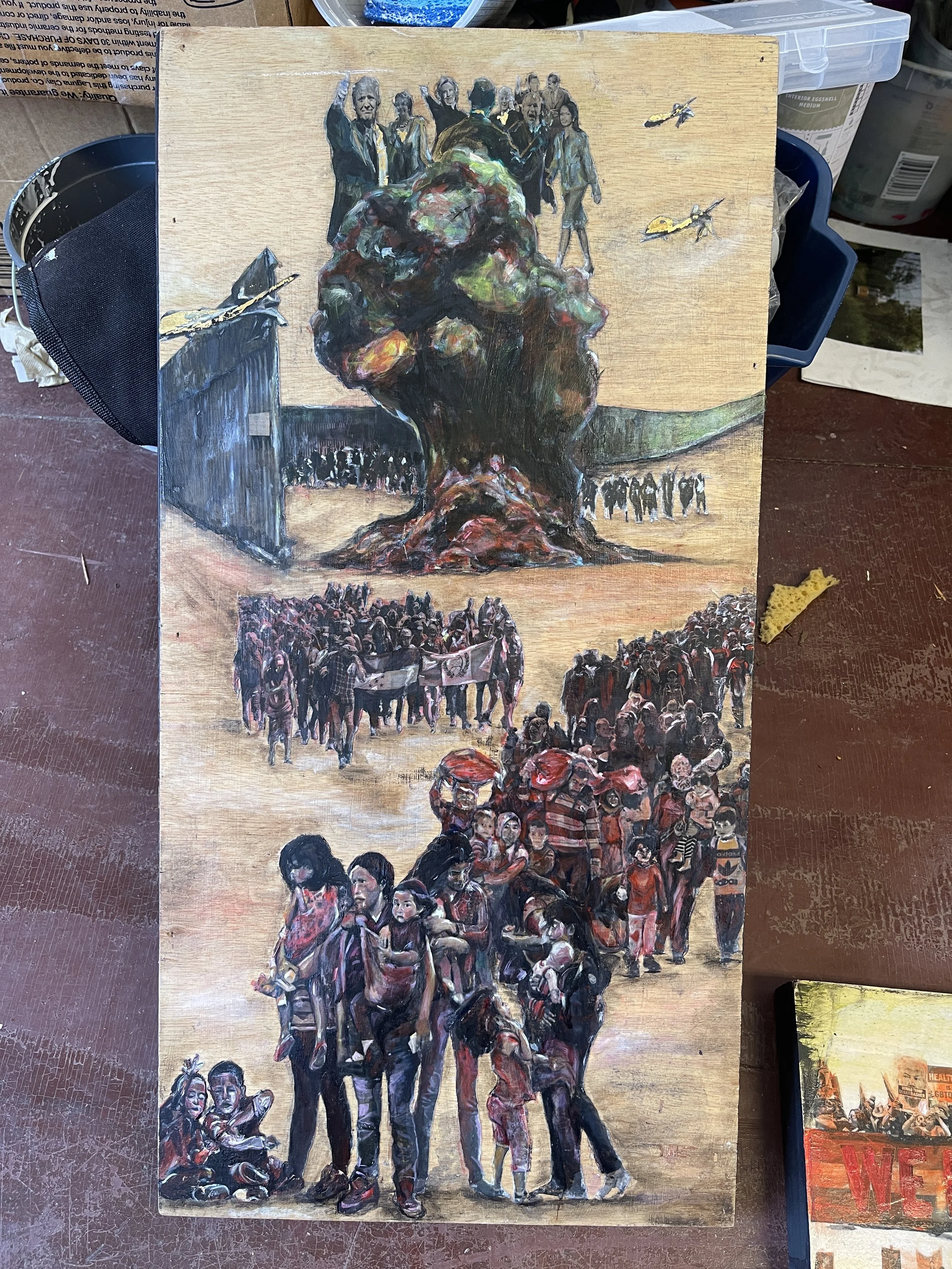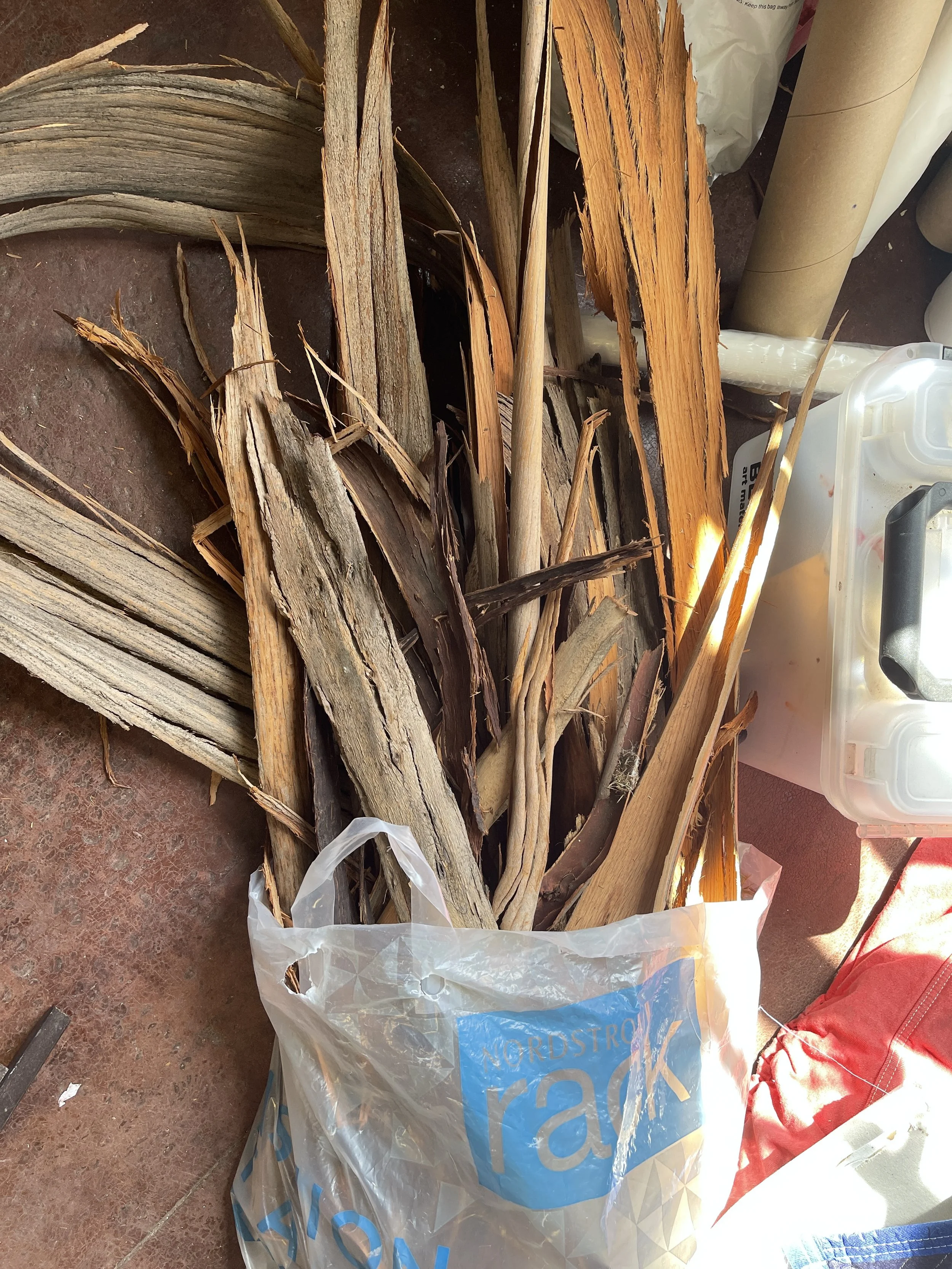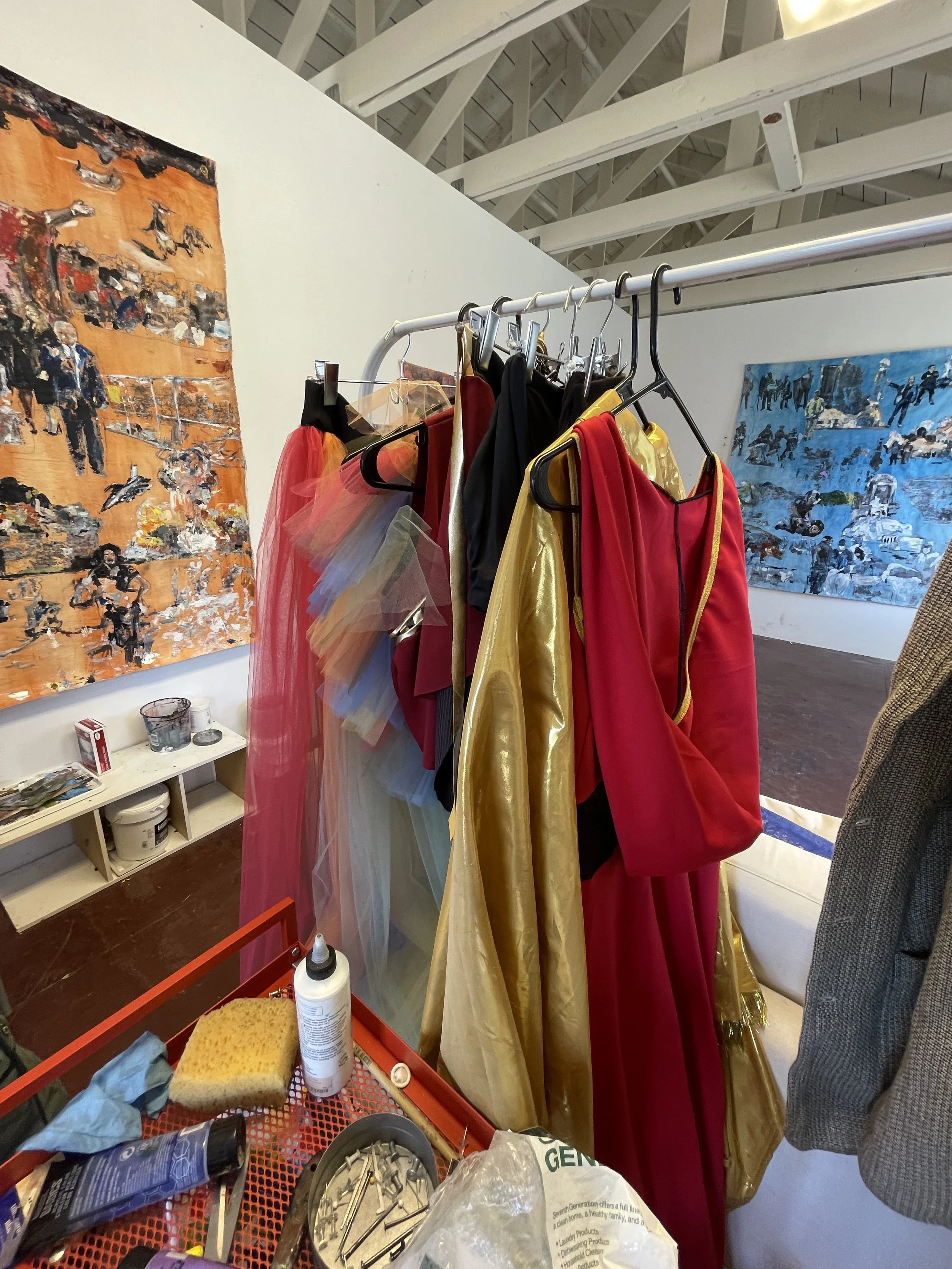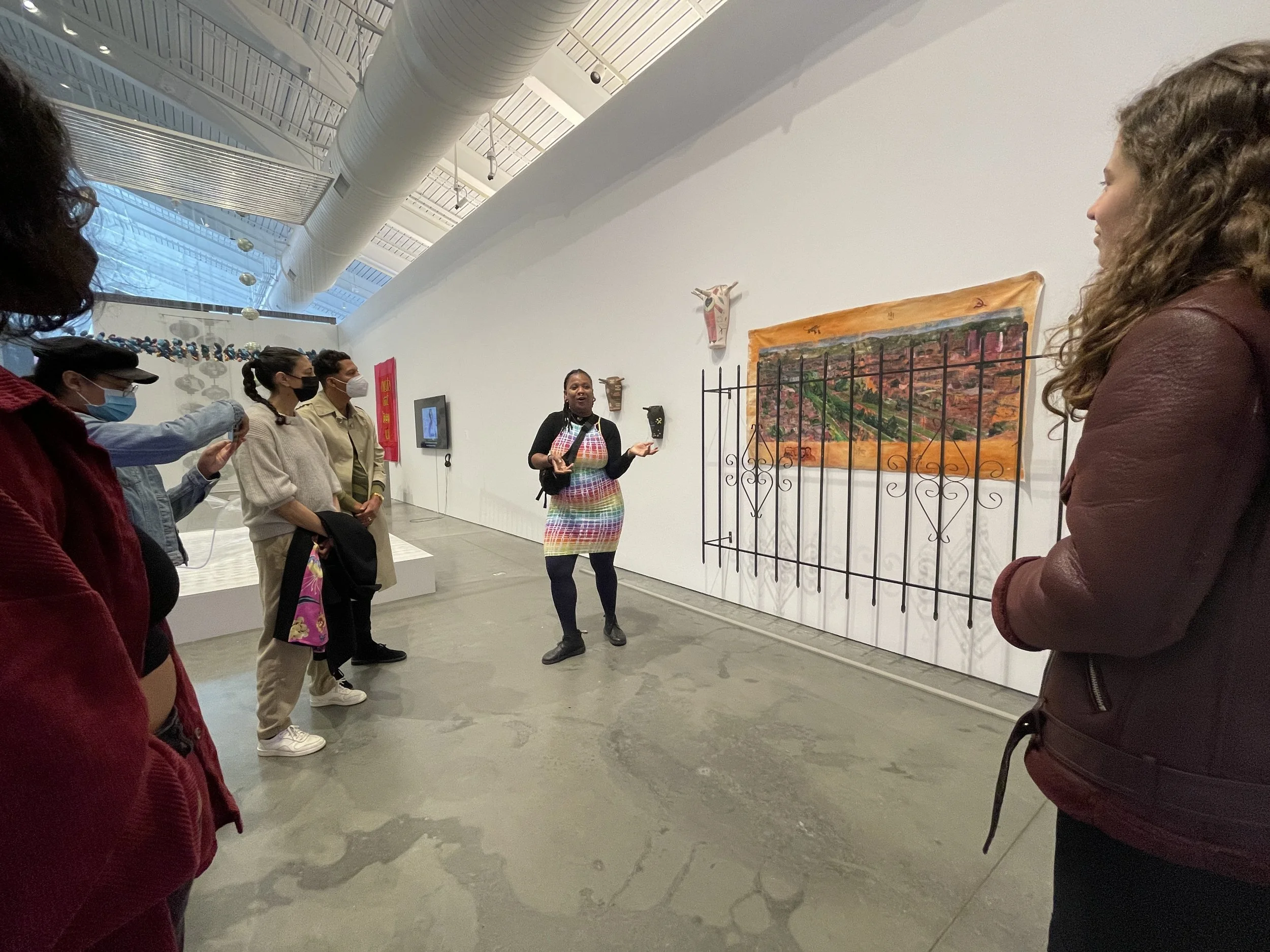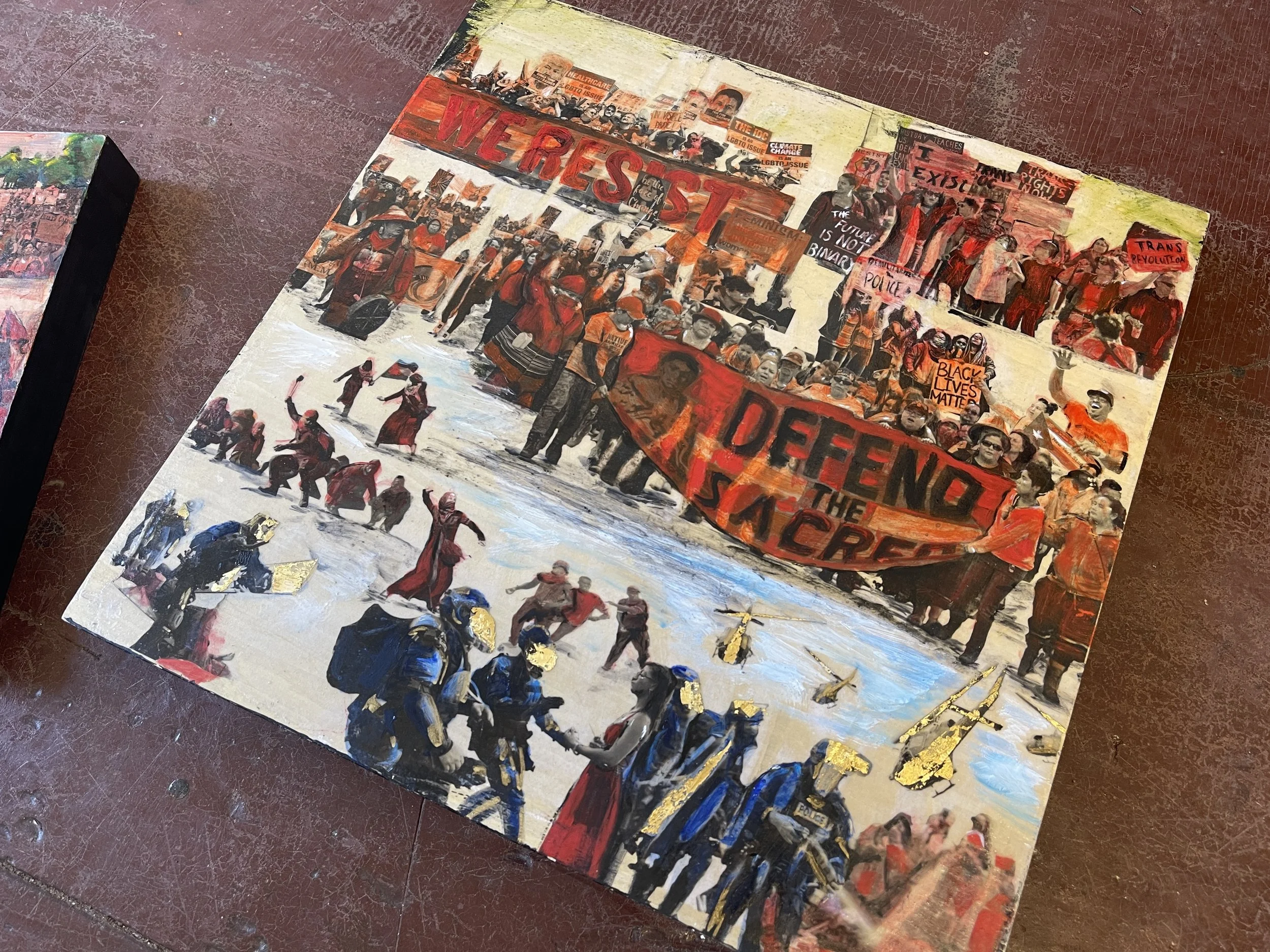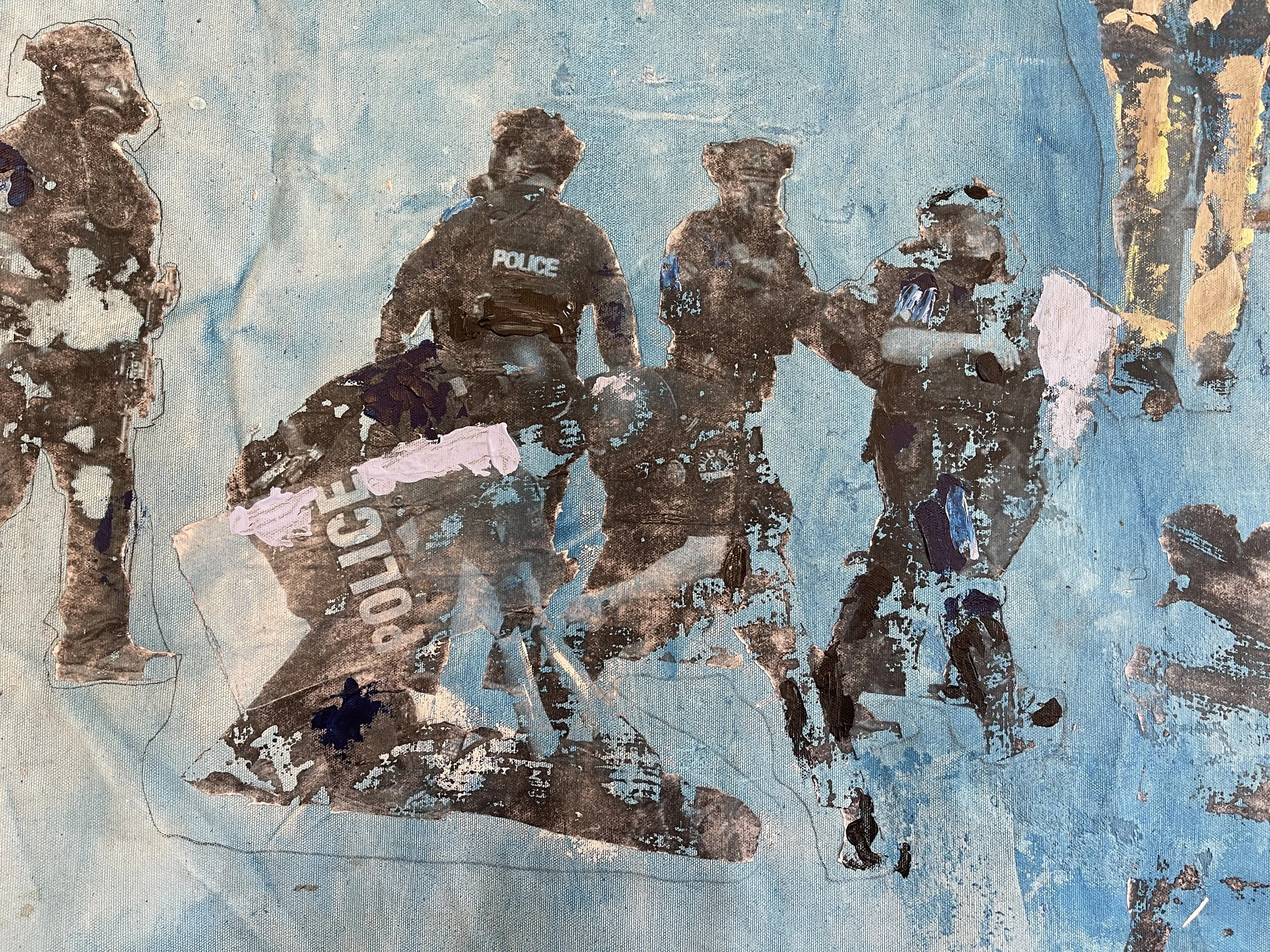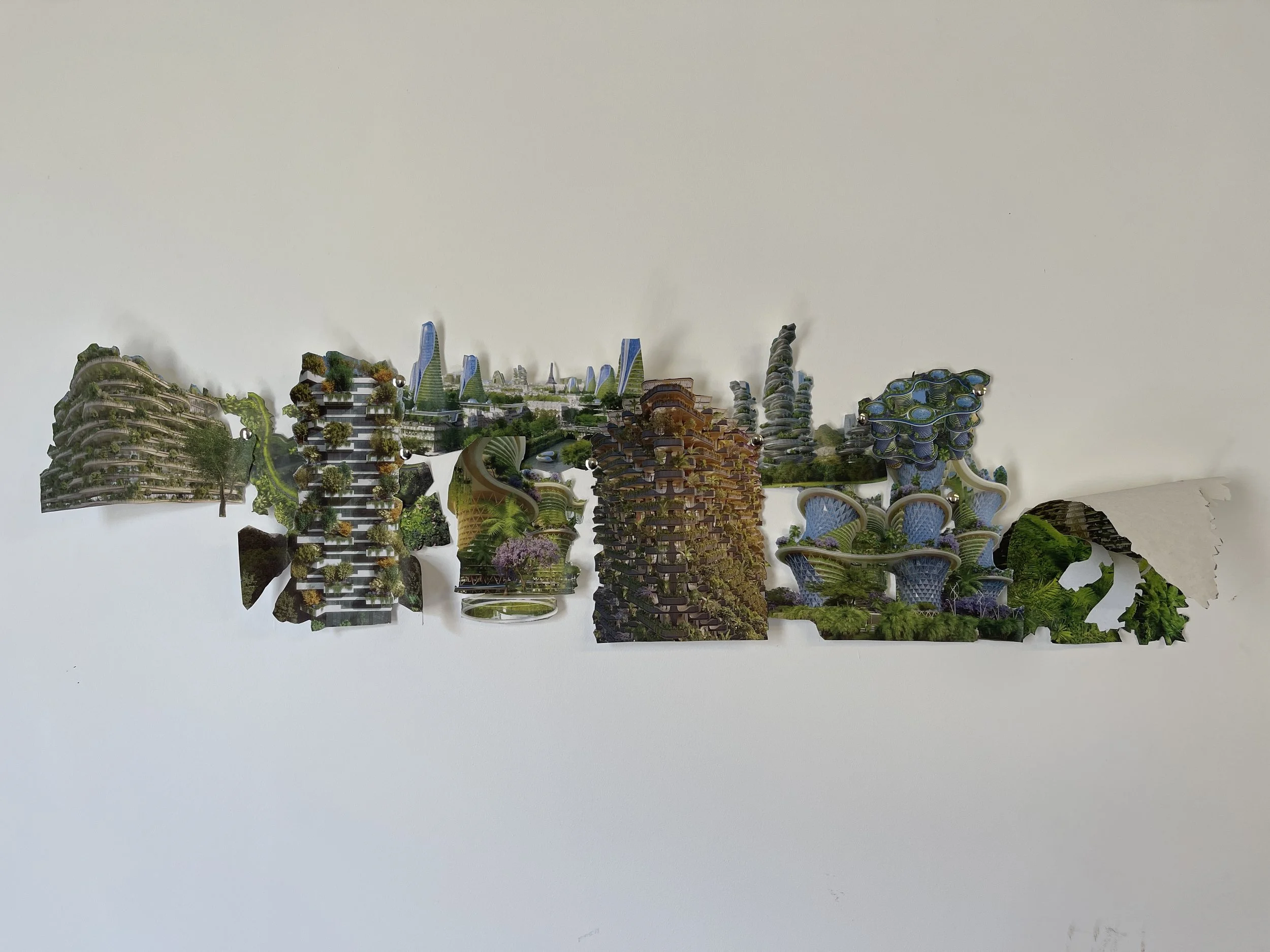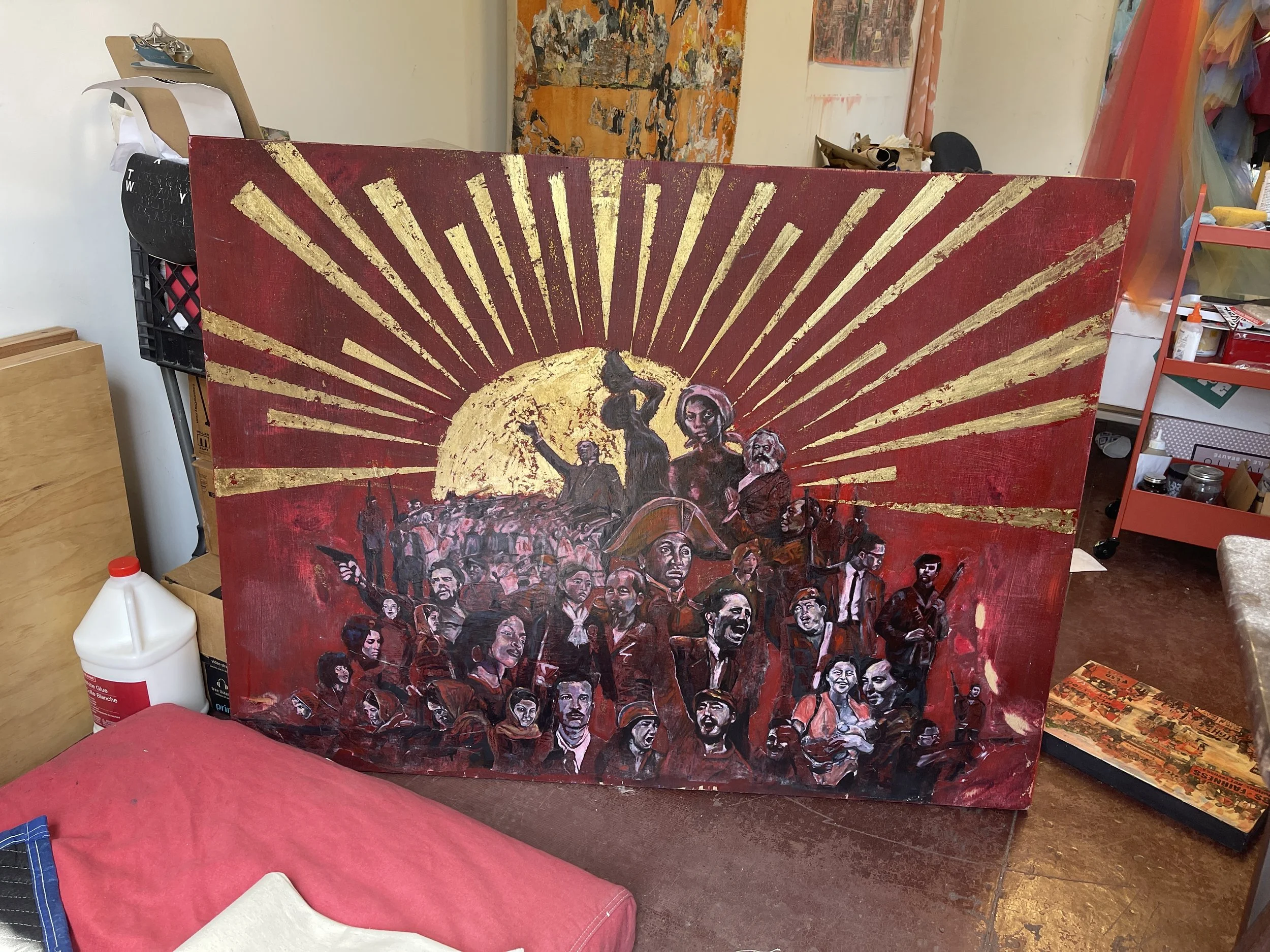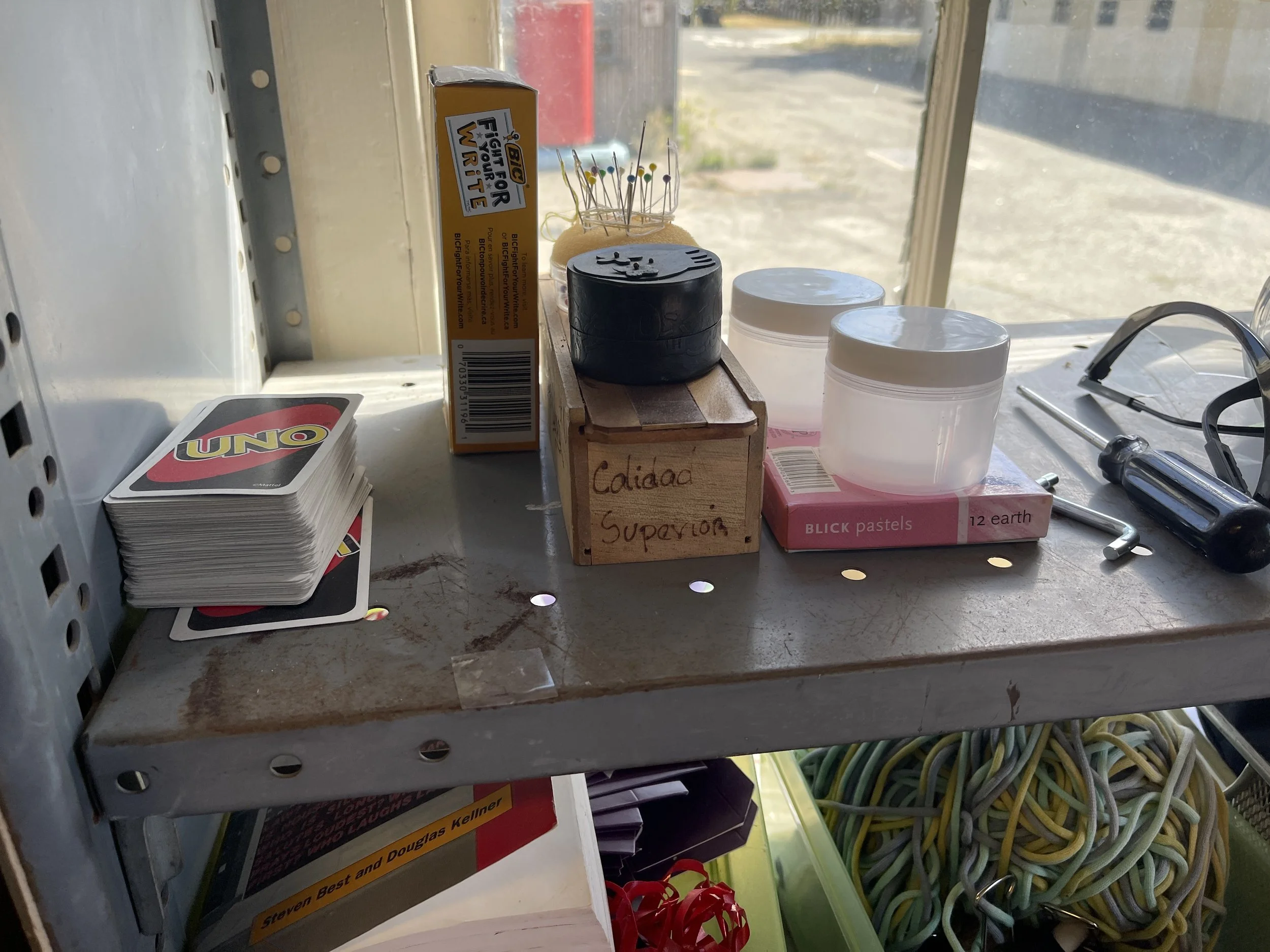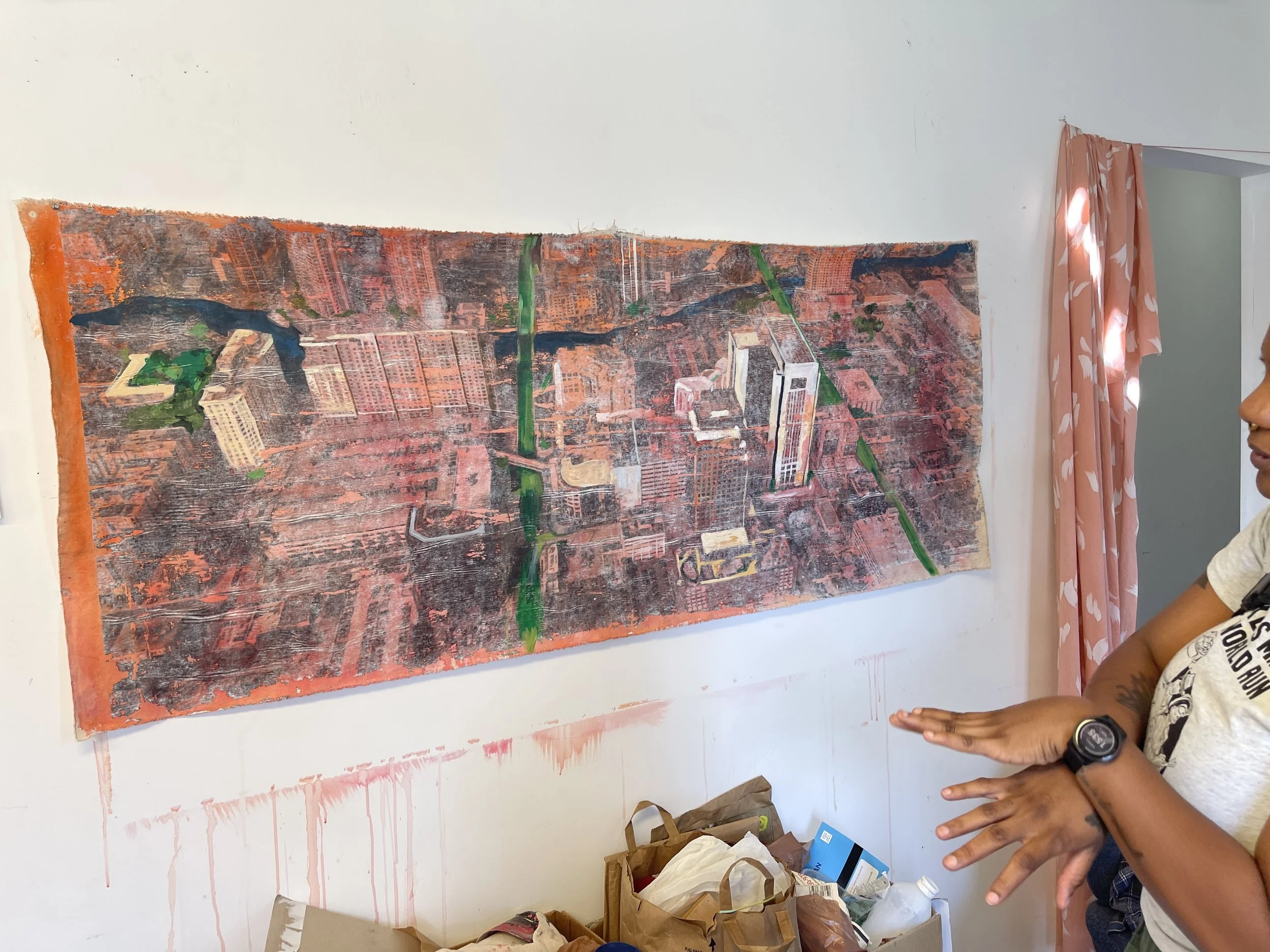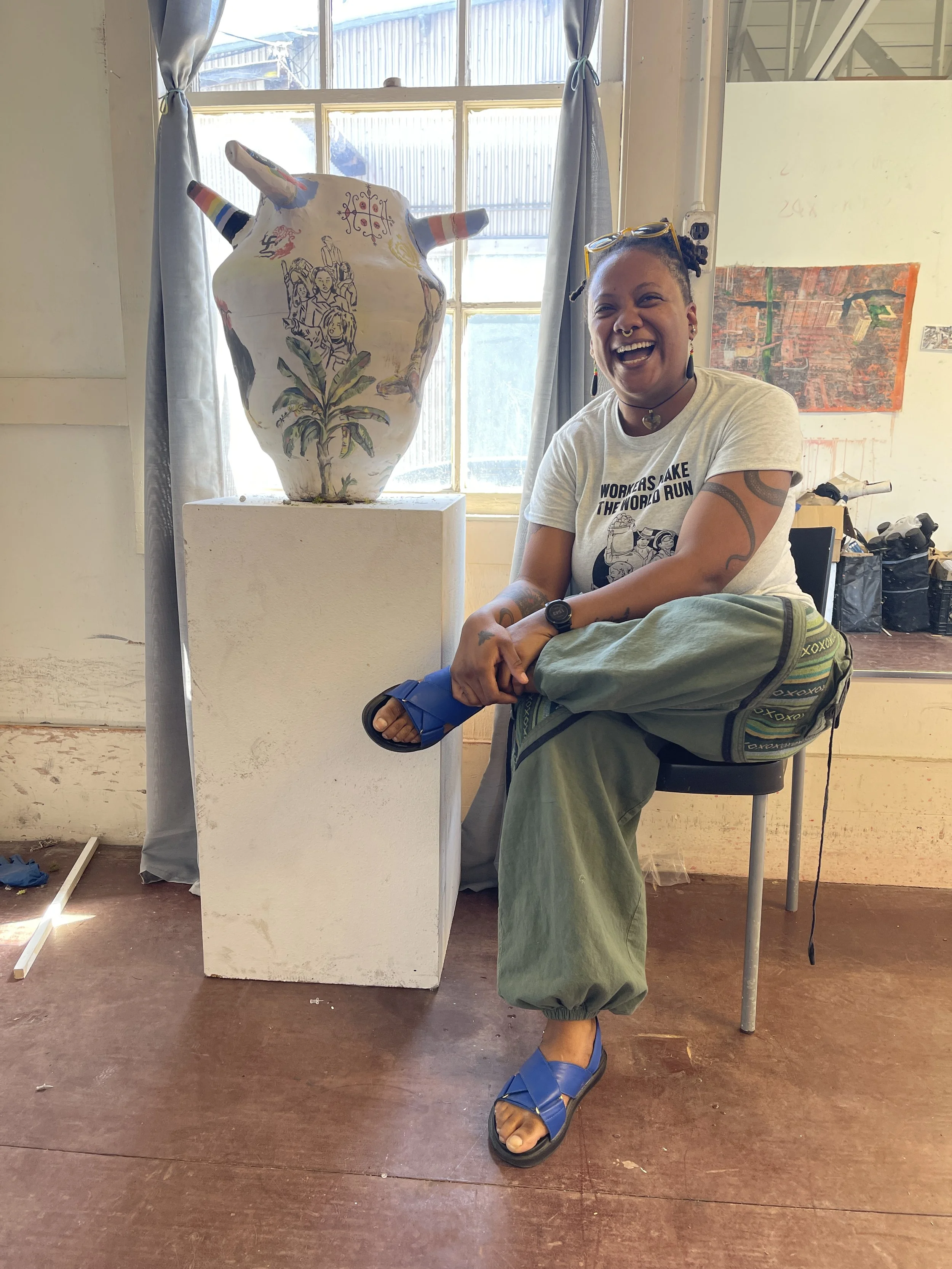Studio Visit & Interview with Rivka Louissaint
By John Vochatzer
To visit the studio of Rivka Louissaint is quite a trek for someone without a car (such as myself). Located basically in the middle of nowhere on an old explosives testing site at the Richmond Field Station wing of UC Berkeley, I made the dual train-plus-bicycle journey out there on a sunny afternoon not too long ago. After getting lost and turned around a few times, I finally made it to where her studio is located—and the location itself was like an eerie, desolate time capsule. There was hardly another soul anywhere to be found out there and the entire area seeped with an almost ghostly quietude. In the back of an old (presumably) barracks, sits Rivka’s studio along with those of other UC Berkeley Grad students, only one other of whom was there on that given weekday afternoon. In the furthest back corner is where Rivka does her work, and where some of her epic, transcendent and revolutionary mixed media works from her years in University are stored with other more recent works-in-progress.
As an individual, I’m not really sure where to begin about Rivka other than saying she is someone that I am incredibly proud to know, and that I am very happy exists in this world. I think many artists, myself included, often struggle with doubts as to whether we are using our creative platforms and our voices for enough, when there is so much rampant injustice in the world. Some do more than others to enact change, but almost all of us could be doing much, much more. To me, Rivka however embodies the archetype of the socially conscious artist and as someone who’s decided to use their creative gifts almost exclusively for progress and change. A firm proponent of Marxism— the motifs and iconography of revolution are prevalent throughout her work which itself is a vehicle for bringing about the justice and liberation of the oppressed.
Growing up between both rural and metropolitan Haiti, Rivka as a young child has witnessed firsthand the devastating effects of greed and imperialism, both in the ravaging of her home country and in the forms of the inequality and instability that come with being a Black immigrant in the US. Far from wallowing, these life experiences have left her charged and motivated to fight for the world that we should have and that if we break it down, there’s not as much standing in the way of it as it might seem. A natural born educator, the lines between personal creativity, community organizing, and teaching are all fused harmoniously together for Rivka—and within her all of these outlets converge with the common objective of breaking down the barriers that stand between us and that world. Thank you for fighting the good fight, Rivka, and you inspire me to do more.
Interview
Hey Rivka! I had a great time visiting your studio out in Richmond. It was for sure one of the more interesting studios I’ve been to. Can you tell us a little bit about the place that your studio is located?
Hi Johnny! Thank you for going all the way out there to visit me. I know it can be a trek, especially when using public transportation. Commuting to the studio is definitely something I struggled with for the past two years.
A building outside of UC Berkely Richmond Field Station, in Richmond, CA.
The studio is at the Richmond Field Station, a satellite campus of UC Berkeley, located north of Albany in the south shoreline of Richmond. In the 50s, the University purchased the land from the California Cap Company, a manufacturer of explosives that also included the production of mercury fulminate at the site. Now the area is mostly used as a research center for multiple colleges within the university and it is where the graduate studios for the Art Practice program are located.
Because of its history, before we could even set foot on the soil there, students, staff, and faculty have to undergo training where we learn about the history of the place, the contamination that is still present today, the ongoing efforts to rehabilitate the land, and what not to touch/come into contact with while working there (the trees, fruits, soil, etc.). So, along with its secluded location and history, the place itself can be pretty intimidating. But, as you saw, the studios there are very spacious and mine served as a making and mostly viewing space for the past two years.
One thing that I’ve noticed is a recurring motif in your work are odes to your Haitian heritage. What was your childhood in Haiti like, and how is it reflected in your work and in your identity as an artist?
My childhood in Ayiti was split between spending time in the countryside with my grandmother and living in the city with my mother. In the small town of Mapou, I spent a lot of time in nature, I learned to plant vegetables and grow plants. In the city, I went to school and was often surrounded by uncles and male cousins who sat around and played dominoes and discussed politics. Imperialism had devastating effects on the island and the signs of that were very blatant throughout my childhood. Because of greed and corruption, resources were not invested in the people, and poverty was prevalent in most places that you looked. During my last few years living in Ayiti, political instability was rampant, food shortages were constant, and often I would wake up and not be able to go to school because of riots.
Rivka with a traditional Haitian vessel she made.
So at a very young age, class, economic inequality and state instability were things I was aware of and had to confront. Some of these were things that I also had to come to terms with again when I came to the US, where on top of the issues that arise with being Black immigrants here we also went from being middle-income working-class to becoming low-income working-class. All of this gave me a strong sense of civic duty and made me realize that a lot of these struggles were interconnected. This is why in my work, I pull from examples of international struggles and fight for the liberation of the oppressed and exploited.
On top of being a student and an artist, you are also a teacher. What has your teaching experience been like? And what kind of gratification do you get from teaching and sharing with others?
Before deciding to pursue art as a career, I worked for a few years as an early childhood educator where I learned a lot about what kind of environment is necessary for teaching and learning to occur. After acquiring that knowledge and practice, being an educator seemed like an extension of being human.
During that time I also started organizing in my community and realized that learning and teaching were key to organizing effectively. This is because both as an organizer and an educator you have to understand, from the beginning, that everyone has the capacity and potential to learn and adapt to new ideas, habits, actions, and commitments.
For me as a cultural worker, art, teaching, and organizing are all tools for liberation. It gives me great joy to know that through my practice I can help create other educators, organizers, and cultural workers and that they can continue the struggle for liberation even after I’m gone.
Another strong current in your work and your overall ethos as a person has been revolutionary and marxist thought and literature. When did you first start exploring these concepts and ideologies, and what is their importance to your work?
When I started organizing, I was introduced to the concepts developed by Karl Marx, Friedrich Engels, Vladimir Lenin, Alexandra Kollontai, Mao Zedong, Walter Rodney and many other marxists. Their insights made me see that Marxism is the antithesis of the currently dominant bourgeois/liberal/capitalist ideology that normalizes the rampant inequality and exploitation we see today and puts profit over the wellbeing of people and the planet. Marxism is important to my work because it allows us to get to the root of our world's current problems and understand them in a scientific way, not in a way wrapped up in immaterial ideas or beliefs. Through this scientific and class conscious understanding of society and through the active organization of working-class, low-income, and oppressed people against the capitalists and those that exploit and oppress us, we can build the world that we all deserve – one where we live in symbiosis with nature and in harmony with each other – today; not in some far-off, distant future.
Something interesting that we talked about, was that on top of dismantling capitalism, it’s equally important to envision what type of society proceeds it. This is something else that you’ve explored both in your art and in your undertakings as a student. How do you envision an ideal post-capitalist society?
I envision a post-capitalist society where earth's resources go to things that benefit society and the planet simultaneously. Where we have a planned economy and work collectively to overcome things like hunger, illiteracy, inequality, lack of access to health care and infrastructure. Where everyone who is able to work, has the right to a job and the necessary assistance to be a productive member of society. Where housing is a human right, not a commodity to be bought and sold on the market.
However, I want to avoid this concept of “ideal” because this future I see is based on material things, material conditions; it will come to be out of the dialectic between the world that came before it and its contradictions. Many solutions to today’s problems already exist and are executable today, but they are not being widely implemented because we live in a society controlled by a tiny, anti-democratic minority (the capitalists) that puts their profits over the well-being of people and the planet.
What is the importance of sustainability to you as an artist? And how do you incorporate it into your work?
I understand sustainability as the equilibrium between economics, society, and ecology as well as the guarantee that future generations will be able to have a quality of life equal to or greater than the one we have today. Unfortunately, in today’s capitalist society that responsibility to reach this equilibrium is often put on individuals. Under the current liberal/capitalist ideology it's up to the individual to pull themselves up by their bootstraps, help the less fortunate, and save the environment all through their own, individual effort. None of this takes into account the systems that allow these inequalities and crises to exist in the first place. This is why in my work I strive to go to the root of the problem and highlight the deleterious nature of systems like capitalism, patriarchy, and white supremacy. I also do a lot of work organizing in my local community to promote climate solutions that go beyond the options given to us by capitalism. I, for example, recently chaired an event that discussed the many ways that we can solve the climate crisis today and promoted a recent book by Tina Landis which talks about exactly this.
Can you tell us a little bit about the work that was on display in the UC Berkeley Graduate MFA exhibit at the BAMPFA?
My installation at BAMPFA was my attempt at envisioning a possible future where we have surpassed the constraints of the present systems of oppression and exploitation. It included ceramic vessels, sound, a painting, and a metal sculpture.
Rivka explaining her installation to a group of friends at the BAMPFA UC Berkeley Graduate exhibit.
Utilizing the shapes of traditional Haitian rada drums I made functional, sculptural ceramic vessels that combined veves – cultural symbols of the African diaspora –with, among other revolutionary iconography, the hammer and sickle – an international symbol of working-class unity and revolution. I included within the vessels the voices of different people reciting a manifesto of hopes and wants for the future. In it they speak of living in a world without class, where race doesn’t exist, where gender has been transcended, where money is irrelevant, and where everyone has their basic needs fulfilled.
The painting depicts a version of Oakland that has green belts and public light rail lines instead of being polluted and choked by highways and private cars. Instead of the gray concrete of the city, I depicted an urban forest to give an idea of what a more ecologically harmonious Oakland would look like. This vision of a future Oakland, however, is obstructed by the metal gate sculpture, symbolizing the current societal and economic barriers that stop us from attaining this reality.
Who are some contemporary artists that you think are creating important work right now and are deserving of recognition?
There are a few contemporary artists that I think are creating important work right now and they come to mind for different reasons. Some are creating anti-imperialist and anti-capitalist work that speaks to our society’s current struggle such as Shenby (@Leftaesthetic) and Haitian artist, Rachel (@muvagaia). Other artists, like Bay Area local Sydney Cain (@sagestargate) and Malaya Tuyay (@mah.lie.yuh), are making work that focuses on ancestral and personal trauma as well as healing. Lastly, I recently discovered the work of Madjeen Isaac (@madjxo) a US artist of Haitian descent living in New York who creates work that calls for environmental justice, food equity, and that centers the stories and hopes of Black and Caribbean people.
Something you mentioned you’re excited to immerse yourself more in, is community organizing. What will this look like for you and your art practice?
My goal is to make community organizing an integral part of my art practice. I hope to help make art and art making accessible to working-class and low-income communities so that they can use it to understand and grapple with the social, economic, and ecological issues of our time. I hope to do this so that they come to see art as a tool to engage society for social justice and in order to support their struggles for their rights and liberation.
Now that you’ve graduated with your MFA, what’s next on the horizon? Where do you want to be taking your work?
Now that I’ve graduated with my MFA, my goals are to continue being an art educator, create work that is socially engaging, find a sustainable and accessible studio to produce work, collaborate with different artists, and explore different mediums and ideas. Finally, I am also looking for more opportunities to exhibit my work locally, nationally and internationally.
Already, I had the opportunity to collaborate on a social practice course with Professor Jill Miller at the University of California, Berkeley. Working on this course with Jill was very enlightening and inspiring. This hands-on experience has already helped me to fuel a more community focused and collaborative approach to my art making practice.
In addition to this, I was awarded the 2022-23 Gerardo Marin post-doctoral fellowship at the University of San Francisco. As part of this prestigious fellowship, I am teaching an art course each semester at USF while I continue to work on my creative practice and become familiar with the service and responsibilities required of university faculty members. I was also appointed a senior faculty member as a mentor to help strengthen the continued development of my artistic research, my art making practice, and to make sure I succeed in academia.
Lastly, I am taking part in two exhibitions in November, the AXA Art prize 2022 award exhibition in Tribeca, New York, and the Broward College Alumni exhibition at the Rosemary Duffy Larson Gallery in Fort Lauderdale, Florida.
